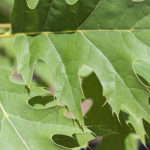Fall Hazard tree lists explained

It’s fall; it’s planting season for trees and evergreens. This time of the year breathes new business, new opportunities, and new money into the landscape industry.
Spring tree supplies have been exhausted in many varieties. So only what is left, is grown in a pot, or can be dug in the fall will be available. Here’s the bad news. The list of tree varieties that can NOT be dug is very long!

Unlike the spring there is a shorter recovery time for trees as soil temperatures dip below 50 degrees. Root reestablishment and elongation cease. This is significant because a tree loses about 75 to 80 percent of its root mass when dug. One source stated that only 2 to 8 percent of the root survives harvesting. This is extremely significant for evergreens and for trees especially as caliper increases. It’s all about moisture! From the moment a tree is dug until it is planted and prepared for its first long winter, moisture is the most important factor.
Desiccation is a killer.
Factors that lead to desiccation or moisture loss are key to which trees are traditionally fall-dug and those that become part of the "fall hazard" lists:
1. Thin-barked Trees
Gleditsia (Honeylocust) is on most nurseries’ hazard lists. If you have handled locusts you know that you can damage its paper-thin bark without any effort (this is strike one for this Genus).
Acer rubrum (Red Maple) also has a thin bark but is regularly dug in the fall because of its very fibrous root system, but usually in smaller caliper. I have seen maples with serious tip dieback after harder winters and for calipers over 3”. Betula (Birch) as well has thin bark - and has at least two more strikes against it.
2. Harvest Time
Spring or fall trees are usually dormant or breaking dormancy when they are dug. We usually think of full dormancy occurring when a tree’s leaves fall off or as trees have set their buds for the next season. These don’t necessarily happen at the same time. We regularly have tree varieties such as Amelanchier, Acer, Malus (Crabapple), Ginkgo, and Tilia (Linden) fall-dug and shipped with some leaves attached but their buds for the new year are set.
Gleditsia are among the first trees to lose their leaves but this does not help (see below). Quercus (Oak) may set their buds but have leaves that hang on very late in the season and in some cases only release in the late winter or early spring. As such they are considered not to be fully dormant until it is too to dig them.
3. Coarse Roots
If you have never handled bare-root stock this may not mean much to you. Acer, Tilia, and Malus to start have very fibrous root systems and dig very well in the fall. Malus actually seem better with fall digging than spring. One assumes their root systems have begun to recover. Gledtisia (again) have few, large, and very coarse root systems.
Many nut-bearing trees such as Quercus have fewer, tap roots. These types of root systems offer little support to the whole tree for moisture. Many of the these tree types do not die but result in varying types of dieback or thinning. Gleditsia will have tip dieback as well as random branch death from the trunk. Quercus will often have severe branch dieback, resprouting only off the main trunk; a very unsightly recovery usually requiring replacement. Betula despite have a fairly fibrous root system has very shallow roots susceptible to drying out and supports a very heavy branch system. Top dieback and branch death usually occur; these trees will take several seasons to recover.
Trees such as Quercus and others can be dug if they have been spring root-pruned in preparation for a fall harvesting. Many nurseries are not that proactive.
Harvesting practices have changed and advanced through the years but the industry is cautious and conservative. Be aware of fall hazard lists. They may save you much grief and even more money. The good news is that the selection of pot-grown trees is increasing every season.
